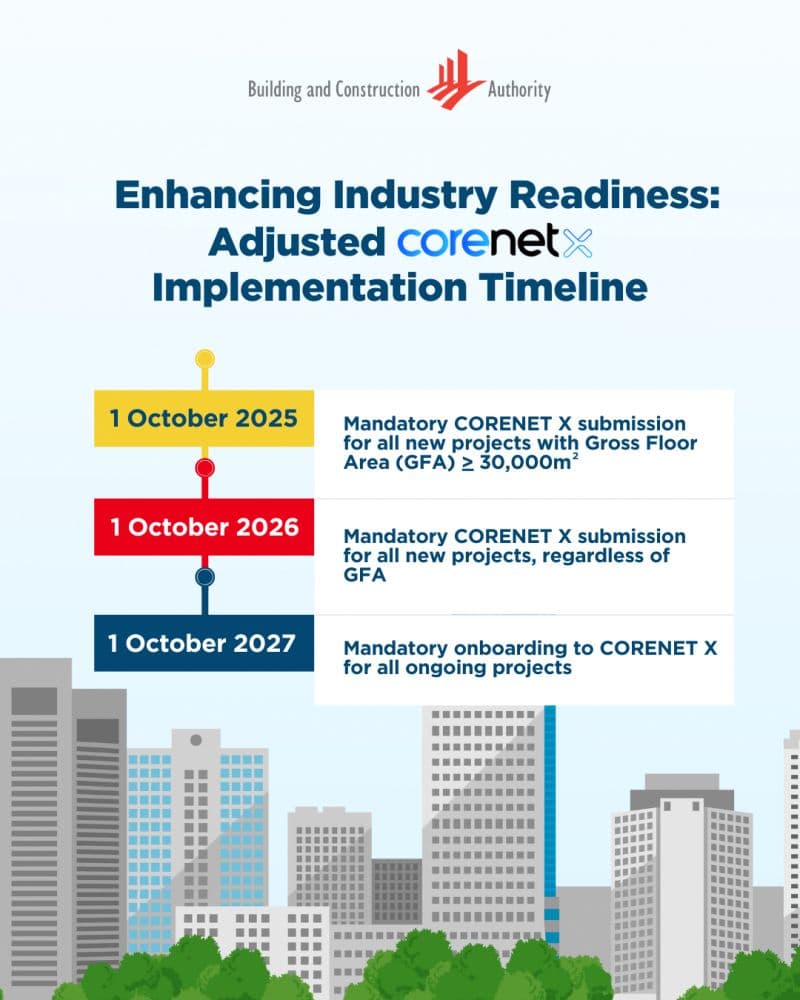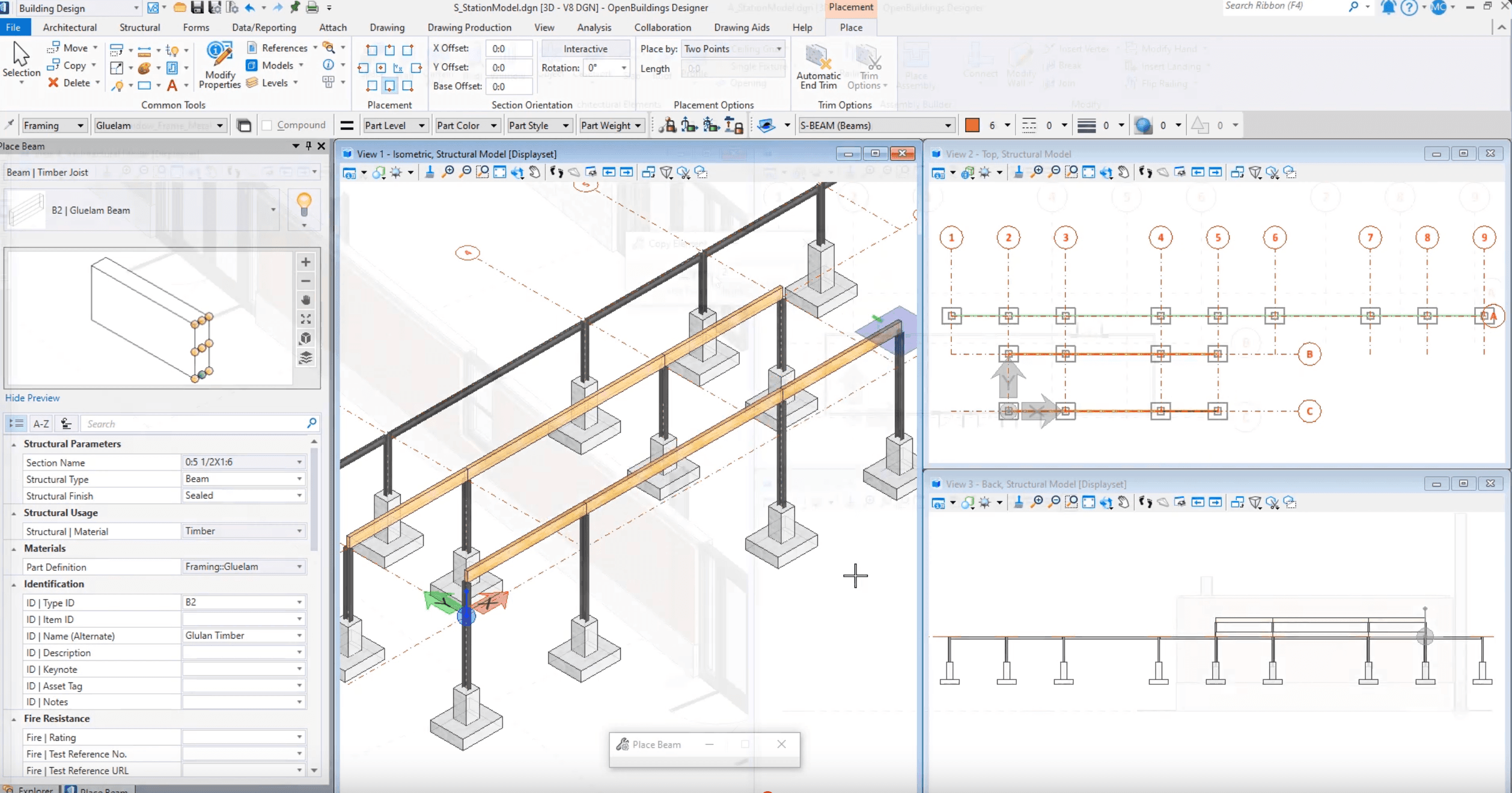- Published on
CORENET X vs CORENET 2.0: Why Starting using BIM?
- Authors

- Name
- Jane Sison
- about
Building Information Modeling (BIM) is a methodology for creating a digital representation of a building’s physical and functional characteristics. It serves as a collaborative tool that integrates data from different disciplines—architectural, structural, and services—into a unified 3D model. This approach promotes coordination, minimizes errors, and streamlines workflows across a building’s lifecycle, from design and construction to operation. In Singapore, the CORENET X platform is an effort to centralize the regulatory approval process for building works.
CORENET X and OpenBIM
In Singapore, the CORENET X platform is an effort to centralize the regulatory approval process for building works. By adopting OpenBIM standards like IFC (Industry Foundation Classes), CORENET X enables:
- Parametric and Geometric Checks: Agencies can automatically assess BIM models for compliance with regulations.
- Improved Collaboration: A unified digital format ensures alignment between regulatory agencies and facilitates collaborative 3D workflows amongst project teams.
CORENET X simplifies submissions, reduces errors, and accelerates approvals, making BIM an essential part of public-sector project delivery.
CORENET X vs CORENET 2.0
CORENET 2.0 faces issues with fragmented processes and inefficiencies. Multiple submission touchpoints often lead to delays and contradictory approvals between agencies. CORENET X addresses these challenges by consolidating submissions into a streamlined process with just three key touchpoints, significantly improving the regulatory approval process for building works.
Under CORENET X, BIM models must be submitted in the IFC+SG format, which is a Singapore-specific extension of the IFC standard. This data format contains mandatory parameters required by regulatory agencies such as the Building and Construction Authority (BCA), Land Transport Authority (LTA), Urban Redevelopment Authority (URA), and National Environment Agency (NEA).
By capturing all relevant building data in a federated BIM model, the different regulatory agencies can provide a consolidated response for regulatory approvals.
How Will You Be Affected?

With CORENET X, BIM becomes the default mechanism for regulatory submissions. Project teams must adapt to:
- Upfront Modeling: Detailed and coordinated BIM models are essential early in the project.
- Deeper Collaboration: All disciplines and trades must work together to ensure consistency across the design, construction, and handover.
- Submissions via CORENET X Portal: Regulatory agencies rely on BIM in IFC format for regulatory approval.
To help the industry get ready, the BCA has provided extensive resources and training materials to help AEC firms get up to speed via the IFC+SG Resource Toolkit. Another particularly helpful resource is the demo environment for the CORENET X portal, which contains profiles (e.g., QP, QP Assistant, Contractor, Engineer) for the industry to familiarize themselves with the new system.
2D Is Not Dead

While a federated BIM submission is essential for CORENET X, it does not mean that 2D drawings are no longer needed. In fact, certain details (see above) like fabrication drawings or concrete body plans contain typical information that is better captured in 2D. Additionally, certain regulatory agencies may still require 2D drawings for specific submissions.
A better approach is to use the 3D model as the foundation for the development of plans, sheets, and drawings. By creating a federated, clash-free BIM model that incorporates all relevant trades, AEC firms can generate 2D drawings as needed, ensuring that all stakeholders have access to the most accurate and up-to-date information.
The Benefits of BIM
BIM is transforming project delivery, especially in the public sector, and firms that adopt it now can gain a strategic edge in an increasingly digital industry. Beyond meeting compliance requirements, BIM enhances efficiency, reduces risk, and supports long-term asset value. Key benefits include:
Improved Coordination
3D models enable early clash detection, preventing costly rework from conflicts like overlapping ducts and beams.
Better Planning (4D BIM)
Integrating time into the model allows simulation of construction sequences, optimizing schedules and preventing equipment access issues.
Accurate Costing (5D BIM)
Real-time cost estimation linked to the model helps manage budgets, streamline tendering, and reduce material miscalculations.
Facility Management (6D BIM)
BIM models serve as living documents for facilities management, maintenance, and energy optimization.
Offsite Manufacturing
BIM supports Design for Manufacturing and Assembly (DfMA), enabling higher-quality prefabrication, reduced waste, and faster on-site assembly.
The adoption of the IFC standard facilitates these workflows, as its format allows critical data parameters to be captured directly in the BIM model.
Common Challenges for BIM Adoption
Despite the potential benefits to the industry as a whole, the move towards the CORENETX platform is not without its challenges. The need for more upfront modeling means that architects and engineering consultants will need to push their supply chain to submit accurate, clash-free BIM models early in the project. Failure to do so can result in delays in the permitting process.
Nonetheless, there are several mitigating strategies that firms can employ to speed up the process of BIM development, which include:
Common Data Environment for Effective BIM Federation
A BIM Common Data Environment (CDE) is a centralized platform where project teams can access, manage, and exchange information throughout the project lifecycle. Robust CDEs like Autodesk Construction Cloud, ProjectWise, and Trimble Connect offer real-time collaboration, version control, and structured data management—all critical for maintaining model integrity across disciplines.
Take ProjectWise, for instance. It enables BIM Managers to define and deploy 2D and 3D seed files that include predefined views, drawing standards, and annotation styles. These templates provide a consistent starting point for project documentation, helping teams reduce setup time and enforce modeling standards from day one.
When implemented well, a CDE ensures everyone is working from the same source of truth—minimizing errors, miscommunication, and rework across design and construction teams.
Virtual Design and Collaboration
Traditional desktop tools like Navisworks have their place, but modern BIM collaboration is increasingly happening in the cloud. Platforms like BIMcollab, Speckle, BIM Collaborate Pro, and ProjectWise allow teams to interact with 3D models in real-time from any location.
Many of these tools now support automated checks for common issues like hard clashes, missing IFC+SG data, and model completeness. Issue tracking is integrated directly into the 3D environment, so clashes and design problems are documented with screenshots, viewpoints, and responsibilities—eliminating the need for clunky Excel sheets.
Instead of taking on the whole of model development, architects and engineers can push the development of the combined services BIM model further downstream to the respective trades.
Reuseable BIM Library for Rapid BIM Development
Developing IFC+SG-compliant BIM object libraries with your supply chain pays off in the long run. It ensures that incoming models from external partners meet regulatory requirements and conform to your standards from the outset.
This approach improves model consistency and streamlines the submission process—especially in jurisdictions like Singapore, where adherence to the IFC+SG schema is a prerequisite for regulatory approvals.
A BIM object library can be beneficial to the trade contractors. Instead of developing a BIM model from scratch, they can leverage existing objects that have already been validated for compliance. This reduces the time and effort required to create a clash-free model for design compliance.
The Bimeco Platform is a free BIM object hosting service that allows firms to create, share, and reuse BIM objects that comply with the IFC+SG schema. It provides a centralized repository for BIM objects, making it easier for teams to find and use the right components in their projects.
Reduce Project Risks with Early Model Checking
One of the key requirements under CORENET X is the inclusion of IFC+SG parameters—mandatory data fields expected by agencies such as BCA, LTA, URA, and NEA. Missing or incorrectly filled parameters can lead to failed submissions and costly delays in securing approvals.
To support this, free tools like the IFC+SG Model Checker are available. This tool validates your models against the IFC+SG schema and highlights any missing or incorrect data, allowing issues to be addressed before submission.
Contractors and their subcontractors should make early model checking a routine part of their workflow. If issues are flagged, the respective model owners should be held accountable for making the necessary corrections. This approach reduces rework, improves submission success rates, and helps keep your project on schedule.
The Way Forward: Mandatory BIM Submissions for CORENET X
BIM is no longer optional for building projects in Singapore; it is a necessity. CORENET X has made regulatory approvals more streamlined and efficient, but it requires a shift in how projects are planned and delivered. While 2D workflows remain relevant for specific tasks, BIM’s benefits in coordination, cost estimation, and asset management are undeniable. By adopting OpenBIM practices and investing in the right tools and training, firms can future-proof their workflows and thrive in an increasingly digitized industry.